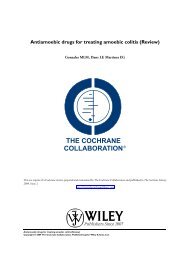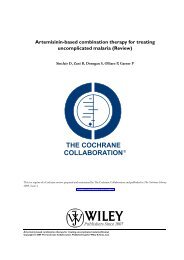Legislative smoking bans for reducing secondhand smoke exposure ...
Legislative smoking bans for reducing secondhand smoke exposure ...
Legislative smoking bans for reducing secondhand smoke exposure ...
Create successful ePaper yourself
Turn your PDF publications into a flip-book with our unique Google optimized e-Paper software.
Braverman 2008 (Continued)<br />
two variables - a) age (P =0.004) with respondents being older and b) having changed jobs(P =0.018). No significant<br />
change in <strong>smoking</strong> prevalence and tobacco consumption between T1 and T2 in those who responded at baseline<br />
and 4 months and those who responded <strong>for</strong> all surveys.<br />
Interventions <strong>Legislative</strong> <strong>smoking</strong> ban introduced in Norway on 1st June 2004 in indoor workplaces including <strong>smoking</strong> in bars,<br />
nightclubs and restaurants.<br />
Outcomes Self-reported <strong>smoking</strong> status (daily, occasional, non-<strong>smoke</strong>r) self-reported average number of cigarettes consumption<br />
<strong>smoke</strong>d daily and at work.<br />
Biochemical verification: No<br />
Notes Examined predictors of <strong>smoking</strong> cessation such as age, gender, income, <strong>smoking</strong> behaviour, attitudes towards the<br />
ban and SHS, <strong>exposure</strong> to SHS, and respiratory symptoms.<br />
Brownson 1995<br />
Methods Country: USA<br />
Setting: Missouri, USA<br />
Design: Observational study, cross-sectional population based surveys carried out on a monthly basis between January<br />
1990 and December 1993. Analysis of never and <strong>for</strong>mer <strong>smoke</strong>rs which were defined as having <strong>smoke</strong>d less than<br />
100 cigarettes in their lifetime and not currently <strong>smoking</strong>.<br />
Participants Population based sample of Missouri residents aged ≥ to 18 yrs.<br />
Total: 6052 interviews over study period; approx. 126 interviews per month.<br />
Response rate: 73%. Sample age 18-34 yrs: 31.8% , Census % Missouri 18-34 yrs: 35.9%<br />
Sample Female: 59.6%, Census % Missouri Female: 52.9%.<br />
Sample representative of overall Missouri population although slightly under-represented in younger persons, males,<br />
blacks, and persons with lesser education.<br />
Analysis: Student’s t test. Regression analyses. Two tailed.<br />
Interventions Missouri statewide clean indoor air legislation implemented in August 28th 1992 restricted <strong>smoking</strong> in workplaces,<br />
public buildings, and restaurants. Bars, taverns, bowling alleys, restaurants with seating <strong>for</strong> less than 50 persons and<br />
certain public places were exempt from the law.<br />
Outcomes Self-reported <strong>exposure</strong> of non<strong>smoke</strong>rs to tobacco <strong>smoke</strong> at work and in the home.<br />
Biochemical verification: No<br />
Notes Other outcomes reported in the study were awareness of the state clean indoor air law and extent to which they<br />
requested no-<strong>smoking</strong> seating in restaurants.<br />
<strong>Legislative</strong> <strong>smoking</strong> <strong>bans</strong> <strong>for</strong> <strong>reducing</strong> <strong>secondhand</strong> <strong>smoke</strong> <strong>exposure</strong>, <strong>smoking</strong> prevalence and tobacco consumption (Review)<br />
Copyright © 2010 The Cochrane Collaboration. Published by John Wiley & Sons, Ltd.<br />
28








